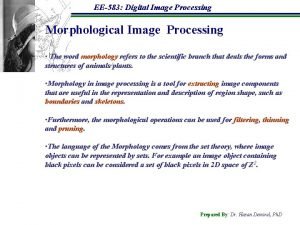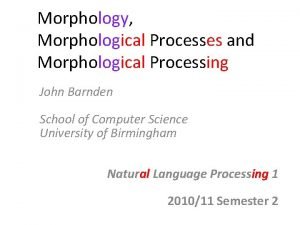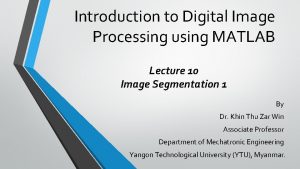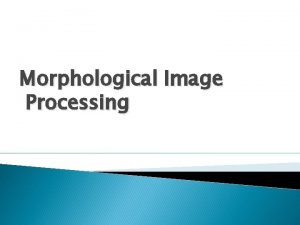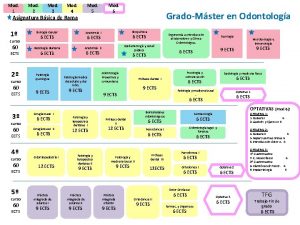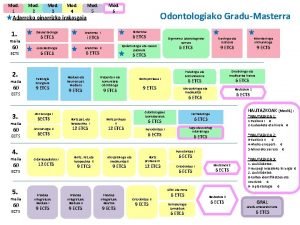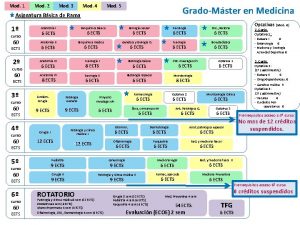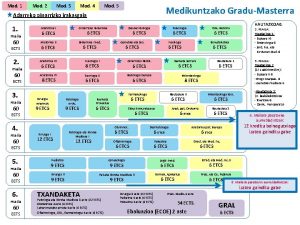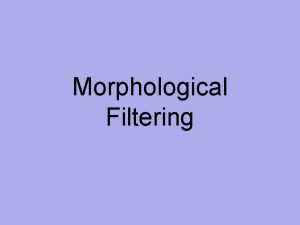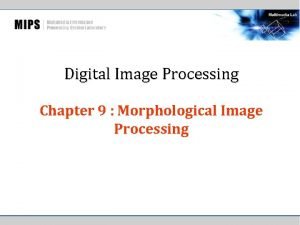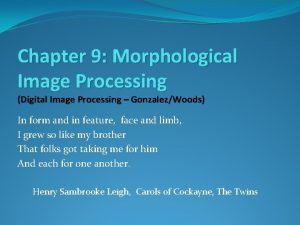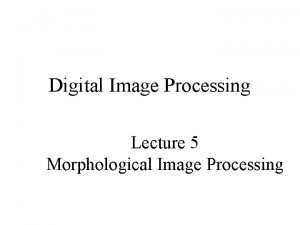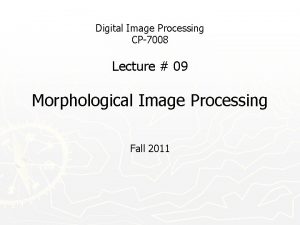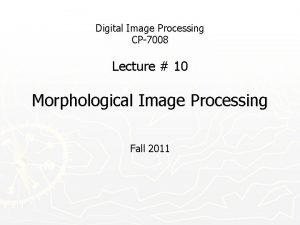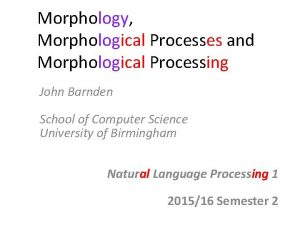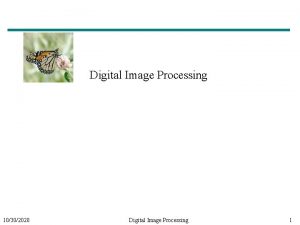MOD 5 Morphological Image Processing Digital Image Processing






















- Slides: 22

MOD 5: Morphological Image Processing (Digital Image Processing – Gonzalez/Woods)

9. 5 Basic Morphological Algorithms � 1 – Boundary Extraction � 2 – Region Filling � 3 – Extraction of Connected Components � 4 – Convex Hull � 5 – Thinning � 6 – Thickening � 7 – Skeletons

9. 5. 1 Boundary Extraction �First, erode A by B, then make set difference between A and the erosion �The thickness of the contour depends on the size of constructing object – B

9. 5. 1 Boundary Extraction

9. 5. 2 Region Filling �This algorithm is based on a set of dilations, complementation and intersections �p is the point inside the boundary, with the value of 1 �X(k) = (X(k-1) xor B) conjunction with complemented A �The process stops when X(k) = X(k-1) �The result that given by union of A and X(k), is a set contains the filled set and the boundary

9. 5. 2 Region Filling

9. 5. 3 Extraction of Connected Components �This algorithm extracts a component by selecting a point on a binary object A �Works similar to region filling, but this time we use in the conjunction the object A, instead of it’s complement

9. 5. 3 Extraction of Connected Components

This shows automated inspection of chickenbreast, that contains bone fragment The original image is thresholded We can get by using this algorithm the number of pixels in each of the connected components Now we could know if this food contains big enough bones and prevent hazards

9. 5. 4 Convex Hull �A is said to be convex if a straight line segment joining any two points in A lies entirely within A �The convex hull H of set S is the smallest convex set containing S �Convex deficiency is the set difference H-S �Useful for object description �This algorithm iteratively applying the hit-or-miss transform to A with the first of B element, unions it with A, and repeated with second element of B


9. 5. 5 Thinning � The thinning of a set A by a structuring element B, can be defined by terms of the hit-and-miss transform: �A more useful expression for thinning A symmetrically is based on a sequence of structuring elements: {B}={B 1, B 2, B 3, …, Bn} �Where Bi is a rotated version of Bi-1. Using this concept we define thinning by a sequence of structuring elements:

9. 5. 5 Thinning cont �The process is to thin by one pass with B 1 , then thin the result with one pass with B 2, and so on until A is thinned with one pass with Bn. �The entire process is repeated until no further changes occur. �Each pass is preformed using the equation:

9. 5. 5 Thinning example

9. 5. 6 Thickening �Thickening is a morphological dual of thinning. �Definition of thickening. �As in thinning, thickening can be defined as a sequential operation: �the structuring elements used for thickening have the same form as in thinning, but with all 1’s and 0’s interchanged.

9. 5. 6 Thickening - cont �A separate algorithm for thickening is often used in practice, Instead the usual procedure is to thin the background of the set in question and then complement the result. �In other words, to thicken a set A, we form C=Ac , thin C and than form Cc. �depending on the nature of A, this procedure may result in some disconnected points. Therefore thickening by this procedure usually require a simple post-processing step to remove disconnected points.

9. 5. 6 Thickening example preview �We will notice in the next example 9. 22(c) that the thinned background forms a boundary for the thickening process, this feature does not occur in the direct implementation of thickening �This is one of the reasons for using background thinning to accomplish thickening.

9. 5. 6 Thickening example

9. 5. 7 Skeleton �The notion of a skeleton S(A) of a set A is intuitively defined, we deduce from this figure that: a) If z is a point of S(A) and (D)z is the largest disk centered in z and contained in A (one cannot find a larger disk that fulfils this terms) – this disk is called “maximum disk”. b) The disk (D)z touches the boundary of A at two or more different places.

9. 5. 7 Skeleton � The skeleton of A is defined by terms of erosions and openings: � with � Where B is the structuring element and k successive erosions of A: indicates � k times, and K is the last iterative step before A erodes to an empty set, in other words: � in conclusion S(A) can be obtained as the union of skeleton subsets Sk(A).

9. 5. 7 Skeleton Example

9. 5. 7 Skeleton �A can be also reconstructed from subsets Sk(A) by using the equation: �Where Sk(A) that is: denotes k successive dilations of
 Digital image processing
Digital image processing Erosion
Erosion Histogram processing in digital image processing
Histogram processing in digital image processing Point processing and neighbourhood processing
Point processing and neighbourhood processing Neighborhood processing in digital image processing
Neighborhood processing in digital image processing Image processing
Image processing Image enhancement point processing techniques
Image enhancement point processing techniques Image transform in digital image processing
Image transform in digital image processing Optimum notch filter in digital image processing
Optimum notch filter in digital image processing Image compression in digital image processing
Image compression in digital image processing Image segmentation in digital image processing
Image segmentation in digital image processing Fidelity criteria in image compression
Fidelity criteria in image compression Image sharpening and restoration
Image sharpening and restoration Image geometry in digital image processing
Image geometry in digital image processing Steps in digital image processing
Steps in digital image processing Walsh transform in digital image processing
Walsh transform in digital image processing Image geometry in digital image processing
Image geometry in digital image processing Noise
Noise Morphological processing
Morphological processing How to shrink a rubber band
How to shrink a rubber band Representation and description in digital image processing
Representation and description in digital image processing Threshold image matlab
Threshold image matlab Introduction to digital image processing
Introduction to digital image processing

